11 July 2014
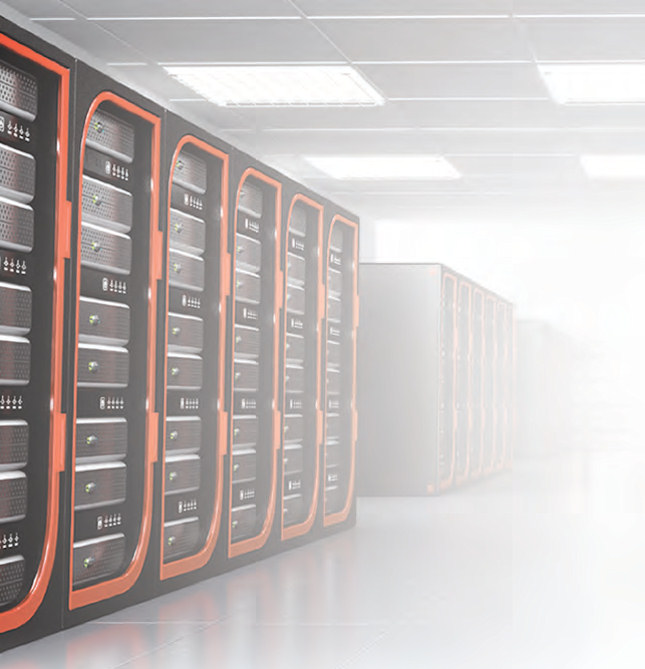
An array of choices: vendors such as Toshiba advocate a tiered approach to storage architectures using a range of HDD and SSD technologies.
When it comes to storing data, enterprise users can choose from a variety of well-established options. But with newer technologies now set to disrupt the marketplace, RAHIEL NASIR finds out if they are ready for business.
From corporations to consumers, the good ol’ hard disk drive (HDD) has remained a staple when it comes to storing data. But with all of us now creating mountains of the digital stuff each day, can it still be relied upon for looking after all our precious bits and bytes, especially for enterprise users where data, as well as time, is now money?
Data recovery specialist Kroll Ontrack recently pushed out a stat that said HDD crashes remain the leading cause of data loss around the globe. It surveyed 1,066 business and consumer users across Europe, North America and Asia Pacific, and found that 72 per cent of them had experienced their most recent data loss from a desktop or laptop HDD. That was followed by 15 per cent who blamed a solid state drive (SSD) failure and 13 per cent who used RAID/virtual services.
That’s perhaps no big surprise given the sheer number of HDDs being used around the world today. But Paul le Messurier, Kroll’s programme and operations manager, says storage media fails regardless of type – it is just a matter of when. “Beyond good health practices, businesses and home users should have working redundancies, such as a backup device or service in place, and continuity plan that is current and accessible in the event of a loss.”
That’s certainly sound advice when it comes to ‘Plan B’. But with data losses impacting every type of storage, is there a ‘Plan A’ solution for enterprise users where the risks of data loss due to bad hardware are minimised or even eliminated?
Flash – will it save every one of us?
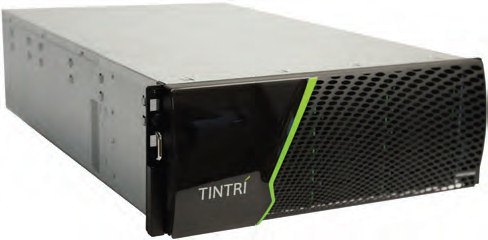
Zycko says appliances like Tintri shown here represent the ‘new ideal’ in storage. They are designed from the ground up to leverage technologies such as flash, SSD, 10GbE, etc, whilst addressing the applications, architectural and technical needs of businesses.
While Kroll’s survey notes that SSDs are also prone to failure, many storage vendors seem to be moving in this direction. At the same time, there is now much talk about flash storage. So what are the pros and cons of using these technologies in the enterprise space?
Martin Bruce, storage sales manager at IBM UK, says that many organisations are considering migrating whole workloads to flash or all-flash arrays, and believes the performance of storing corporate data on any platform, from mainframe to open or virtualised workloads, may be improved with even a small percentage of SSD or flash capability. He says some customers who have done this report exceptional performance and business benefits, such as 95- 98 per cent reductions in processing times, physical footprint and power consumption, as well as 50 per cent lower TCO.
Many of the vendors we spoke to agreed that flash is creating big disruption in the storage market with its promise of greater performance and speed compared to the traditional spinning disk. For instance, Pure Storage claims the preference for mature, legacy, mechanical disk vendors that have been the gold standard for 20 years will tip towards all flash arrays over the course of the next refresh cycle (four to five years).
Matt Kixmoeller, the company’s VP of products, says: “$15 billion will be spent this year alone on ‘performance’ mechanical disk arrays. Such disk-centric arrays (which typically have flash caches) are going to consume five to 10 times the power and rack space of the all-flash alternatives, and perform an order of magnitude more slowly. For database and virtualised applications, performance disk arrays are now a waste of money.”
But many industry experts point out that flash has significant limitations. Dan Leary,VP of marketing at Nimble Storage, says: “On average, it tends to be between eight and 20 times more expensive than conventional hard disk, has lower capacity, and can only withstand a finite number of write/erase cycles before it becomes invalid.”
It’s the same with SSDs. While these also offer compelling advantages such as lower energy consumption and faster data access times, they come with high price tags and low lifespans, according to Toshiba Electronics Europe (the company credited with introducing flash memory in 1984). Nick Spittle, GM of product management, says: “SSDs should not be viewed as the ‘HDD killer’, but rather as a complementary technology to enhance existing storage infrastructure. The NAND chips in SSDs do have a finite lifetime and can resist up to 10,000 write/erase cycles.”
Spittle adds that to protect against data loss, wear levelling and error correction mechanisms are implemented in SSDs. And unlike HDDs, they do not have mechanical parts that can wear out or be damaged by shock. Furthermore, he believes that as NAND prices become more competitive, their application potential will broaden.
Rob Clark, group technical enablement director at IT distributor Zycko, is also optimistic about SSD’s future: “Whilst there are finite write capabilities (and initially we saw a lot of issues with hardware reliability) the latest generations of SSD, especially in the enterprise class platforms, do not really suffer from those reliability concerns.”
Clark says that the performance differentials on flash/SSD are huge – more than hundreds of times faster in some instances – and costs are falling quickly due to wider market adoption.
“It’s also important to note the speed of development within SSD/flash technologies. It has taken us over 50 years to get to an HDD capable of storing 6TB of data, whereas there are already 6.4TB flash media drives available from certain vendors in a 2.5-inch disk size format. General SSDs are already 800GB after just a couple of years of mainstream availability.”
Any need for self-storage?
Should enterprises bother investing in local hardware when they can outsource the problems of data storage to a cloud service provider? If only it were that simple.
Aside from all the usual ‘FUD’ associated with using the cloud, Craig Parker, head of product marketing at Fujitsu UK and Ireland, says that locally deployed hardware solutions are always going to be needed because enterprises are not going to transfer all their data to the cloud. “This may be due to regulatory reasons, access requirements, and data ownership. In terms of the latter, an enterprise needs to be aware in which country its data is going to reside and the data access laws within that country.”
Pure’s Kixmoeller agrees. He says that while cloud is increasingly an integral part of any company’s IT strategy, business and/or security compliance requirements is one factor that can dictate the need for on premise infrastructure. “Of course, speed, resiliency and cost factor into this equation as well, and can tip the balance in one direction or the other, depending on the specific needs and capabilities of an organisation.”
Cloud is often viewed as a cure to storage problems but according to Nimble’s Leary, when you look at the TCO within the service providers, it can be pricier and more complex than it first seems. He says that while a cloud service can provide a good storage solution for applications that are not frequently accessed, it quickly becomes expensive for enterprises running transactional applications, such as databases that require high and frequent access to data.
Edouard Doutriaux, LaCie’s Northern Europe sales director, says the key to the “perfect” storage solution is to define what you are looking to achieve in the day-today running of your business. “We are currently seeing a lot of interest in a hybrid approach whereby data is stored both locally on the hard drive and also in the cloud. This gives organisations control and security that their data is protected, but also the agility to access that information whenever and wherever it is required.”
Doutriaux claims that LaCie is the only external storage company that owns its cloud storage. As a result, he believes his firm is “uniquely” positioned to deliver a “seamless hybrid cloud solution”.
Ultimately, the decision to stay local or go cloud depends on an individual organisation’s data storage needs. Zycko’s Clark says that each business function deserves careful review, and reckons that currently available cloud services are best for disaster recovery (DR) and long-term storage of cold data.
“If you can leverage the economics of cloud provisioning and pay-as-you-use commercial models, DR costs in the cloud versus the traditional ‘build a second data centre’ option can be significantly reduced. Looking at backup, archiving and longer term storage requirements for compliance, if you can encrypt and deduplicate your data before it’s uploaded, some truly fantastic savings can be achieved.”
Clark goes on to say that one main trend affecting the tape and backup markets in general is the ability to tier data of a certain age or type via the REST API into either a public or private cloud storage offering.
‘Old school’ storage
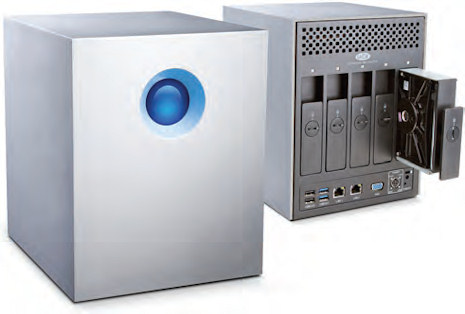
LaCie says its five-bay 5big NAS Pro enables workers to collaborate easily using a single interface for both network/cloud storage and remote access.
Where does all that leave traditional storage options such as the SAN, NAS, and of course tape – are these now destined for the WEEE bin? “Due to the explosion of Big Data, existing storage technology will soon hit a wall, becoming a bottleneck for business productivity,” warns IBM’s Bruce.
Having said that, many vendors support the view that traditional systems are not defunct and are instead leading the way in the next chapter of the evolution of data storage. As a result, new systems are being introduced that are significantly more efficient than their predecessors.
“Tape is certainly not dead,” says Bruce. “IBM continues to develop and invest in this area. Clipper Group has stated that tape storage is 26 times cheaper than disk when viewed over a nine-year TCO.”
He goes on to claim technologies such as the Linear Tape File System, combined with IBM’s Elastic Storage cloud/virtualised platform, can drive down the cost of both conventional SAN and NAS workloads, as well as ease the management of the overall solution. “IBM’s recently announced Elastic Storage can move petabytes of data and billions of files in microseconds versus days, providing faster access to both unstructured and structured data that would conventionally be stored on SAN and NAS.”
Despite its cost advantage, tape is becoming less prevalent in enterprises as users move to disk-based backup solutions. However, some experts such as Clark say that extremely large data requirements for cold data are still, economically at least, best placed on tape infrastructure.
When it comes to network attached storage, LaCie’s Doutriaux enthusiastically proclaims it is far from dead and is in fact evolving to meet the increasing demand for very high-performance solutions. As a result, the company has developed and launched a five-bay NAS device.
“Thanks to hybrid cloud technology, the LaCie 5big NAS Pro lets employees collaborate easily using a single interface for both network/cloud storage and remote access. Wherever the user is or whatever the device (computer or mobile), they can access data quickly from one convenient interface. Administrators can also easily manage users and groups in two mouse clicks. Plus, data stays secure thanks to novice-friendly SimplyRAID and clientside cloud encryption.”
New in store
Other new NAS products from LaCie include a 2-bay unit that has been designed to deliver a combination of speed and security for small businesses. The 2big NAS is powered by a 2GHz processor, features an improved file system, and is said to deliver speeds of up to 100MBps. “Network storage is growing in excess of 40 per cent annually, increasing the demands placed on network storage devices,” says Doutriaux. “The 2big was developed to scale with the needs of SoHo users, delivering fast file sharing and data security, the two most critical factors for a small business.”
Fujitsu has recently announced its new ETERNUS S3 platform which Parker says gives customers the ability to have both SAN and NAS in a single unified controller. “This saves customers in both opex and capex as it means that they do not need to run two disparate storage islands and train their storage teams on different storage technologies from different vendors.”
The company also offers an all-flash array in the shape of the ETERNUS DX200 S3 which can be integrated with its existing infrastructure. Parker says Fujitsu’s software stack provides the ability to automatically position data on the right tier at the right time, and includes QoS to determine system performance for applications during peak periods.
Toshiba also advocates a tiered approach to storage architectures and says a range of HDD and SSD technologies should be used. According to Spittle, by combining SSD’s fast random access read capability and the high capacity of the HDDs, organisations can easily optimise the handling of business critical data and large media files.
“HDDs provide the base with high capacity data storage and SSDs sit on the top providing fast access to mission critical data. Automated algorithms ensure the most suitable drives are used to store data, minimising power consumption and heat dissipation – both of which are critical issues for enterprise storage and data centres.”
He adds that Toshiba offers a full range of storage hardware that includes nearline HDDs, enterprise performance HDDs, and enterprise SSDs, as well as HDDs, SSDs and NAND memory for tablets, phones, laptops and PCs.
Earlier this year, the company launched its highest capacity external HDD, the 5TB STOR.E Canvio. A 4TB model is also available. The new device features NTI Backup Now EZ software to streamline and speed-up the backup process. It scans the user’s system and recommends the best coverage for the computer. Toshiba adds that if the worst happens, users can click the restore button and instantly recover a file or folder. “What’s more, if you boot directly from your STOR.E Canvio hard drive, it will restore all the files saved on your computer. It even includes the ability to burn a boot CD/DVD.”
But away from the traditional solutions, it is clear the flash wars are now on as the technology continues to hog the headlines.
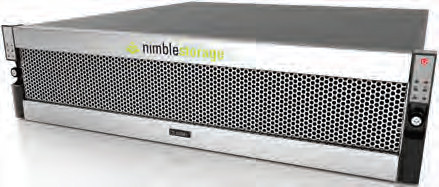
Nimble Storage says that its CS-Series arrays are the building blocks of the Adaptive Flash platform. They can handle various large-scale enterprise workloads such as virtualisation deployments, high transaction-volume databases, Microsoft Exchange, amongst others.
In June, Nimble Storage launched its latest flash products but adds a twist to the tale. The new CS700 Series arrays and All-Flash Shelf leverage the firm’s unique Adaptive Flash platform which is said to provide the performance of flash-only arrays and the capacity of hybrid arrays.
The CS700 Series has been designed to handle a variety of performance-intensive enterprise workloads such as large-scale VDI deployments, high transactionvolume databases, Microsoft Exchange, etc. The All-Flash Shelf is said to provide the flexibility to scale flash gradually up to 16TB per node, or 64TB in a four-node scale-out cluster.
Adaptive Flash is based on Nimble’s patented Cache Accelerated Sequential Layout (CASL) architecture and InfoSight, its automated cloud-based management and support system. Delivering up to 500,000 IOPS, 64TB of flash and a petabyte of capacity, it’s claimed the platform minimises performance and capacity trade-offs, enables the consolidation of all workloads, and eliminates storage silos.
“Organisations are forced to overprovision flash for performance-centric applications, incurring significant costs and other overheads,” states the firm. “Though performance-intensive applications benefit from residing on flash, enterprises are burdened with overheads associated with maintaining the entire working sets within a flash-only environment.”
According to Nimble, the Adaptive Flash platform uses InfoSight to recommend the exact amount of resources required as application demands change within an enterprise. It says this “scale-to-fit” approach allows the non-disruptive addition of resources, thus avoiding over provisioning, under-utilisation, and increased costs.
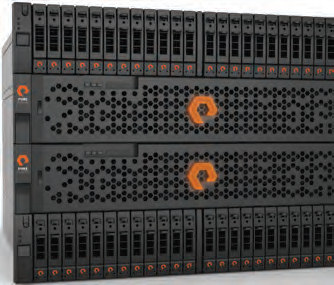
The FlashArray 450 from Pure Storage offers up to 250TB of usable space in a 2U controller footprint, and also introduces support for 16Gbps Fibre Channel connectivity.
Not to be outdone by its fellow Silicon Valley rival, Pure Storage recently unveiled two new models in its flagship FA-400 Series. This includes the FlashArray 450 which is said to be suitable for replacing racks of Tier 1 disk storage for consolidated, virtualised workloads.
Pure says it offers up to 250TB of usable space in a 2U controller footprint, and is powered by two 2.7GHz 12-core Intel processors and 512GB RAM per controller. It also introduces support for 16Gbps Fibre Channel connectivity. The other model is the entry-level FlashArray 405 which offers up to 40TB of usable space in a 1U controller form factor.
Kixmoeller makes some bold claims about his firm’s all-flash arrays. He reckons they’re 10x faster, more space and power efficient, more reliable, and typically cost less than traditional performance disk arrays.
“[They] deliver greater than 99.999 per cent uptime, as measured across our installed base, and do so without performance impact. They remove on average one million hours of latency per year between a business’ applications and the underlying storage, and save enough in power, cooling and operating overhead in the first four years of deployment to pay back customers for the initial purchase price.”
A few weeks ago, Pure announced that it had acquired more than 100 storage and related technology patents from IBM following the signing of a cross-licence deal. The firm says the agreement will enable it to focus more on advancing storage innovation. Clearly, the future of its technology in the enterprise storage market will be no flash in the pan.
-(002).png?lu=245)







